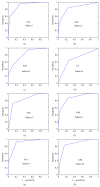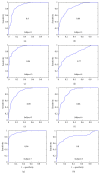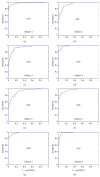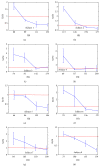High Order Statistics and Time-Frequency Domain to Classify Heart Sounds for Subjects under Cardiac Stress Test
- PMID: 26089957
- PMCID: PMC4450340
- DOI: 10.1155/2015/157825
High Order Statistics and Time-Frequency Domain to Classify Heart Sounds for Subjects under Cardiac Stress Test
Abstract
This paper considers the problem of classification of the first and the second heart sounds (S1 and S2) under cardiac stress test. The main objective is to classify these sounds without electrocardiogram (ECG) reference and without taking into consideration the systolic and the diastolic time intervals criterion which can become problematic and useless in several real life settings as severe tachycardia and tachyarrhythmia or in the case of subjects being under cardiac stress activity. First, the heart sounds are segmented by using a modified time-frequency based envelope. Then, to distinguish between the first and the second heart sounds, new features, named α(opt), β, and γ, based on high order statistics and energy concentration measures of the Stockwell transform (S-transform) are proposed in this study. A study of the variation of the high frequency content of S1 and S2 over the HR (heart rate) is also discussed. The proposed features are validated on a database that contains 2636 S1 and S2 sounds corresponding to 62 heart signals and 8 subjects under cardiac stress test collected from healthy subjects. Results and comparisons with existing methods in the literature show a large superiority for our proposed features.
Figures
















References
-
- Debbal S. M., Bereksi Reguig F. Choix de l'ondelette analysante et classification des signaux phonocardiogrammes en fonction des souffles surajoutés. Afrique Science. 2004;1(1):1–13.
-
- Moukadem A., Dieterlen A., Hueber N., Brandt C. A robust heart sounds segmentation module based on S-transform. Biomedical Signal Processing and Control. 2013;8(3):273–281. doi: 10.1016/j.bspc.2012.11.008. - DOI
-
- Dokur Z., Ölmez T. Heart sound classification using wavelet transform and incremental self-organizing map. Digital Signal Processing: A Review Journal. 2008;18(6):951–959. doi: 10.1016/j.dsp.2008.06.001. - DOI
-
- Gupta C. N., Palaniappan R., Swaminathan S., Krishnan S. M. Neural network classification of homomorphic segmented heart sounds. Applied Soft Computing Journal. 2007;7(1):286–297. doi: 10.1016/j.asoc.2005.06.006. - DOI
Publication types
MeSH terms
LinkOut - more resources
Full Text Sources
Other Literature Sources

